AMD's 785G Chipset - Revolutionary or Evolutionary?
by Gary Key on August 4, 2009 5:00 AM EST- Posted in
- Motherboards
Our first tests today concentrate on Blu-ray playback results using four movies and the three major formats. The Simpsons Movie covers H.264, Dave Matthews and Tim Reynolds Live at Radio City in VC-1, and CRANK for the MPEG-2 crowd. We are also tossing in Wanted for its picture-in-picture capabilities although we tend to like the combination of Angelina Jolie, fast cars, and guns more so than the technical attributes on the disc.
CyberLink’s PowerDVD 9 Ultra is utilized for playback duties in today’s review and it fully supports the decode acceleration capabilities built into the 785G and G41 chipsets. We are still performing tests with a variety of commercial and freeware software applications. Additional test results will be available in our 785G motherboard roundup next week.
The Simpsons Movie –
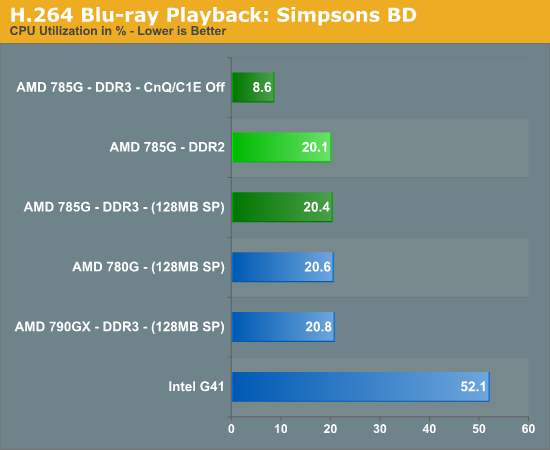
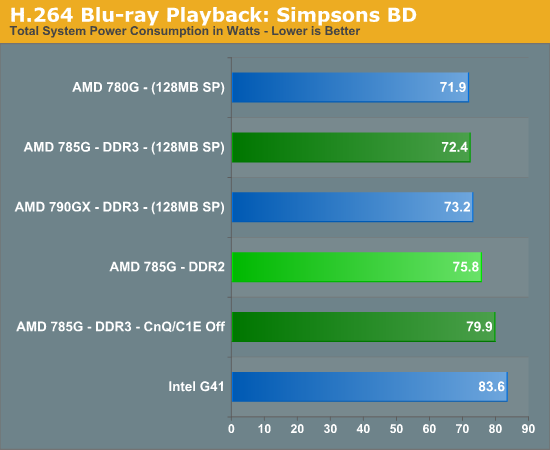
Crank –
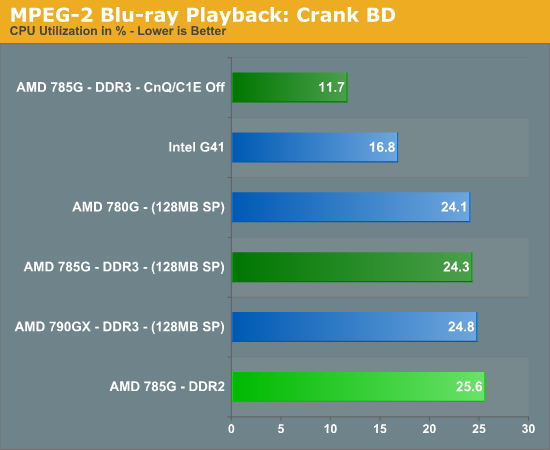
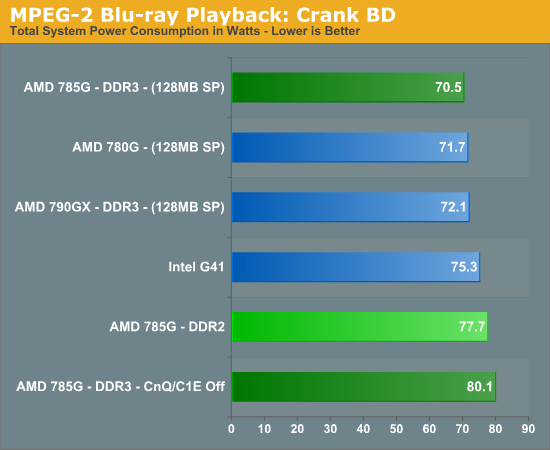
Dave Matthews and Tim Reynolds Live at Radio City –

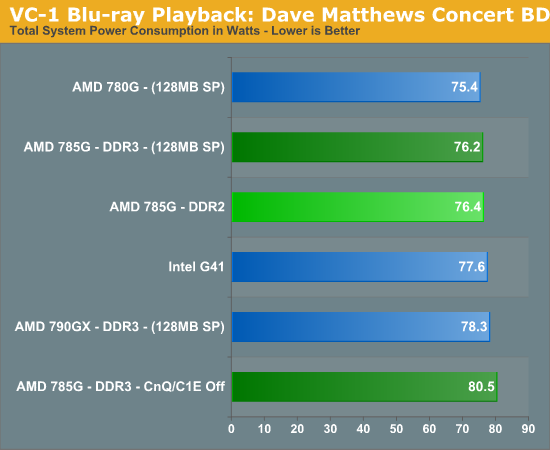
No real surprises here, since the Intel G41 chipset only supports hardware decode support with the MPEG-2 format. The G41 is not competitive with the 785G with H.264 titles but makes a decent showing in our VC1 based title. However, it does offer slightly lower CPU utilization rates in our MPEG-2 title than the 785G, unless you disable CnQ/C1E on the AMD platform.
The 785G DDR3 platform has the best overall power consumption numbers with power management features enabled. In the past, we recommended leaving CnQ disabled in order to ensure proper operation of the system and to avoid an overtly negative performance penalty, but those times have changed. Our 785G DDR2 system is voltage challenged in these tests as we had to manually set the CoreVid to 1.350V (1.332V real) as it would auto set to 1.392V instead of 1.325V. Undervolting the CPU to 1.288 worked fine in our playback tests but not in other benchmarks.
We did not note any substantial differences in playback quality between the 785G and G41, although we tended to prefer the 785G on our larger screens. It just seemed to have a slightly sharper picture even with all post processing effects turned off. We calibrated our monitors and TVs before each screening so a minuet offset in a setting could have affected our results, but our eyes always gravitated to the AMD setup in A/B comparisons.
Of course, the 785G offered significantly more video enhancement options than the G41 if you like to play with that stuff. Vector Adaptive de-interlacing, pulldown detection, edge enhancement, de-noise, dynamic contrast, color vibrance, flesh tone correction, and 1080P/24 were all working correctly in our latest driver set. Yeah, we know, it sounds too good to be true with an AMD driver set, but it worked this time for us.
Wanted-
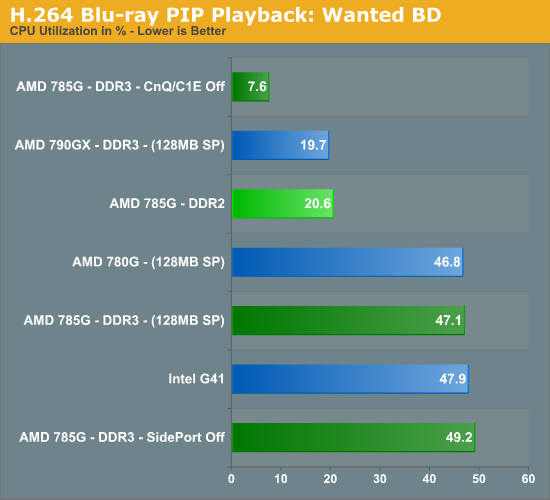
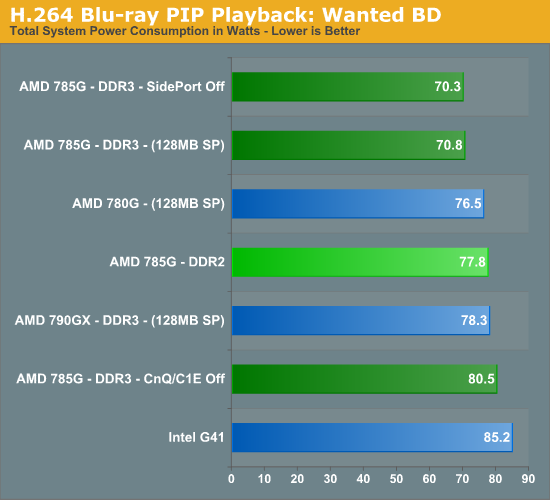
One of the new features of the 785G is hardware assisted picture-in-picture playback capabilities, actually AMD simply states accelerated multiple streams in their specifications. All we know is that it works, and works perfectly with a variety of Blu-ray titles that feature PIP capabilities.
Hulu TV HD
Full
Screen -
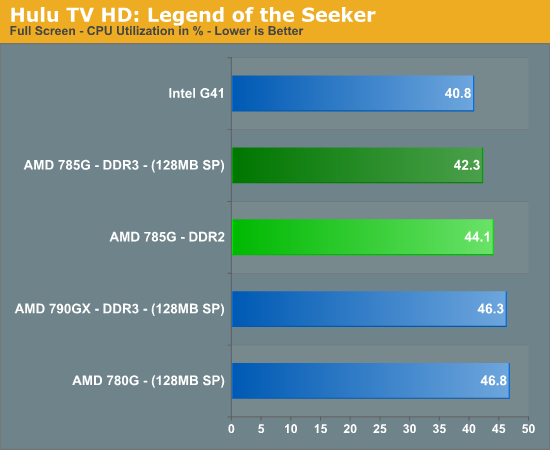
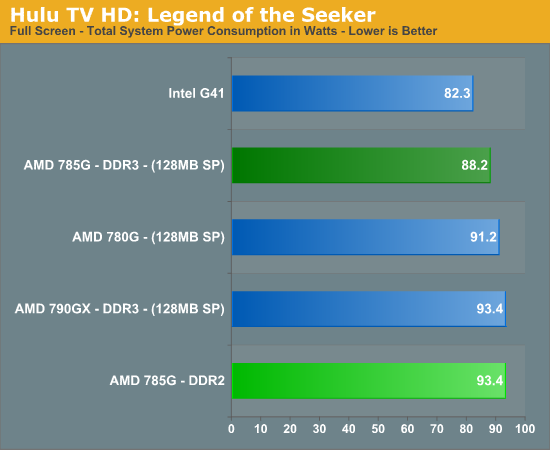
1280x720 -


One of our favorite desktop applications is Hulu. We decided to incorporate this fantastic service into our benchmarks. Some might say that all you really need for decent Hulu playback is a fast internet connection and a system that actually cooperates well with Adobe Flash. We think a fast hard drive, lots of memory, and very good GPU is just as important.
The G41 offers the best CPU utilization rate under full screen mode when streaming our HD title. There is a reason for this; we had occasional judders and stutters during heavy action sequences or pan zooms that did not occur on the 785G platform. The G41 behaved better in 1280x720 mode but we still encountered the occasional stutter, just not as often.




















43 Comments
View All Comments
Hrel - Saturday, August 22, 2009 - link
You showed Nvidia stats on the first page... I guess you didn't include them cause ATI and Intel can't even compare???Next time include the Nvidia results... would've thought that it'd an impulsory action; guess not.
crochat - Tuesday, August 18, 2009 - link
Gary,You mentioned a motherboard roundup in your conclusion. I thought it would come sooner.
Regards
AlB80 - Sunday, August 16, 2009 - link
1. The A-Link Express II is a proprietary interface developed by AMD basing on the PCI Express Gen2 version 2.0 technology, with additional Northbridge-Southbridge messaging functionalities.2. High data transfer bandwidth (up to 2.5 Gb/s / Lane)
Concillian - Saturday, August 15, 2009 - link
"Remember when ATI made crappy chipsets that no one bought, and all AMD systems were built with NVIDIA or even VIA chipsets? "Yeah, I remember that, thats when they were really AMD chipsets and not ATi chipsets with an AMD label on them. ATi started making good Crossfire chipsets shortly before AMD bought them.
I like AMD as much as the next guy, but let's not be patting them on the back too hard. They tried, failed, then did what any good American businessman would do... bought a struggling competitor to use their IP.
IntelUser2000 - Saturday, August 8, 2009 - link
Gary, you got the clock speed of the G41 IGP wrong:http://www.techarp.com/showarticle.aspx?artno=543&...">http://www.techarp.com/showarticle.aspx?artno=543&...
G41 and G43 uses a 667MHz core while G45 uses 800MHz.
Notice the differences here: http://global.hkepc.com/1525/page/3#view">http://global.hkepc.com/1525/page/3#view
ClagMaster - Saturday, August 8, 2009 - link
The 785G is just a 780G which has recieved a fine tuning. Which is OK. There are slight improvements in performance over the 780G but nothing to be excited about. 785G Seems to work well with DDR3 memory and Athlon II processors.I have an ASUS M3A78EM 780G Mobo with an AMD BE2400 X2 CPU I use as a secondary computer I keep off-line for private matters. It's a fairly powerful rig for the media applications I run.
The HD 3200 GPU is just as powerful as a Geforce 4200 graphics card. I can play DX8 and DX9 games from the 2002-2004 period (Max Payne, Aquanox, Homeworld2) with acceptable framerates at 1280 x 1024 resolution. I run Windows XP Home.
The 785G is not bad. But if I had a choice between a 785G mobo and a 780G mobo with the 780G costing $5-$10 less, I would buy the 780G mobo. I can still run Windows 7 with the 780G with the HD3200.
ClagMaster - Saturday, August 8, 2009 - link
BTW-This article was not boring. It honestly compared the performance capabilities of the 785G to other chipsets of its class (780G and G41).
Most differences between the 785G and 780G were small and within the combined statistical uncertainty of the benchmark measurements measurements +/-10% (i.e. statistically insignificant). Not very surprising. Most of the larger differences observed were between systems with DDR2-1066 and DDR3-1333 memory systems.
I agree the 785G is a better balanced chipset than the 780G and G41 for multimedia.
I wish Gary would have used an older benchmarking suite so I can compare the performance between current and systems 2-3 years old. I prefer PCMark2005 and 3DMark2005 since these are reliable indicators of performance. This is important to me because I try to make my purchasing decisions on the criteria of having double the performance for the same cost and power consumption.
ClagMaster - Saturday, August 8, 2009 - link
BTW-This article was not boring. It honestly compared the performance capabilities of the 785G to other chipsets of its class (780G and G41).
Most differences between the 785G and 780G were small and within the combined statistical uncertainty of the benchmark measurements measurements +/-10% (i.e. statistically insignificant). Not very surprising. Most of the larger differences observed were between systems with DDR2-1066 and DDR3-1333 memory systems.
I agree the 785G is a better balanced chipset than the 780G and G41 for multimedia.
I wish Gary would have used an older benchmarking suite so I can compare the performance between current and systems 2-3 years old. I prefer PCMark2005 and 3DMark2005 since these are reliable indicators of performance. This is important to me because I try to make my purchasing decisions on the criteria of having double the performance for the same cost and power consumption.
7Enigma - Thursday, August 6, 2009 - link
Gary,Thanks for the article but could you keep in mind for future articles on non-gaming hardware (i.e. IG's, budget GPU's, etc.) to make sure the game description is in line with the actual article? I can tell they were just copied directly from a previous gaming article, so it's a bit silly to see, "We crank up all the details to max", only to see the data chart show 1024X768 with low settings.
:)
AlB80 - Wednesday, August 5, 2009 - link
DMI 10Gb/s each direction, full duplexaka
4 lane PCIe 1.1